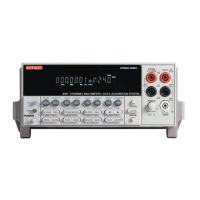3-30 Basic DMM Operation Model 2701 User’s Manual
Effects of open test leads on ohms readings
The Model 2701 will display readings up to 120% of range. Readings above 120% of
range will cause the “OVRFLW” message to be displayed. For example, on the 100Ω
range readings up to 120Ω will be displayed. Above 120Ω, the “OVRFLW” message is
displayed.
The Model 2701 will also display the “OVRFLW” message if a test lead is open during an
ohms measurement. A hardware (H/W) detection circuit or software (S/W) detection is
used to detect an open input lead. For an Ω4 measurement, a software (S/W) detection
routine is used to detect an open sense lead.
Open test lead detection is illustrated in Figure 3-12 for an Ω4 measurement of a 100Ω
resistor using the 100Ω range. For an Ω2 measurement, sense circuity is not used. With
the test leads properly connected, as shown in Figure 3-12A, 1mA is sourced through the
100Ω DUT. The 100mV drop across the DUT appears on the Input Hi terminal.
Resistance is then calculated (100mV / 1mA = 100Ω) and displayed by the Model 2701.
Open input lead detection
100Ω through 1MΩ ranges – For the lower ohms ranges, a hardware detector is used to
detect an ope n input lead. The hardware detector uses a comparator circuit to monitor the
voltage on the Input Hi terminal. Open circuit voltage on the Input Hi terminal is either
6.6V or 12.8V, depending on the selected measurement range (see resistance
specifications in Appendix A). When an input lead (Hi or Lo) is open, as shown in
Figure 3-12B, voltage rises to the open-circuit level, which trips the “OVRFLW” message.
10MΩ and 100MΩ ranges – For the two highest ohms ranges, open input lead detection
is implemented in software. Open circuit voltage for the 10MΩ and 100MΩ ranges is 7V.
For the 10MΩ range, the “OVRFLW” message trips when the open circuit voltage rises to
approximately 3.5V. For the 100MΩ range, the “OVRFLW” message trips when the open
circuit voltage rises to approximately 6.5V.
Open sense lead detection
100Ω through 1MΩ ranges – For the Ω4 function, the sense leads must be connected to
the DUT. As shown in Figure 3-10B, the sense leads connect the voltmeter of the
Model 2701 to the DUT. In general, if a test lead for the voltmeter is open, the reading on
the Model 2701 will randomly drift due to the high impedance circuitry of the voltmeter. If
this were allowed to happen for the Ω4 function, erroneous ohms readings would be
displayed.
To prevent erroneous ohms readings caused by an open sense lead, the Model 2701
implements software to detect an open sense lead. As shown in Figure 3-12A, with all test
leads properly connected, voltage on Sense Hi is at virtually the same potential as Input
Hi, and Sense Lo is at virtually 0V. When a sense lead (Hi or Lo) opens, that terminal will
drift to -15mV and it will trip the “OVRFLW” message. Figure 3-12C shows detection for
an open Sense Hi lead.

